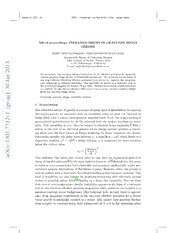
Infrared Issues in Graviton Higgs Theory PDF
Preview Infrared Issues in Graviton Higgs Theory
January31,2013 2:6 WSPC-ProceedingsTrimSize:9.75inx6.5in ghiggs˙mgproc 1 MG13 proceedings: INFRARED ISSUES IN GRAVITON HIGGS THEORY SRIJITBHATTACHARJEE∗;PARTHASARATHIMAJUMDAR Astroparticle Physics & Cosmology Division, Saha Institute of Nuclear Physics, India 3 1/AF Bidhannagar, Kolkata-64 1 E-mail: [email protected] 0 2 We investigate the one-loop infrared behaviour of the effective potential in minimally n coupledgravitonHiggstheoryinMinkowskibackground. Thegravitational analogue of a one loop Coleman Weinberg effective potential turns out to be complex, the imaginary J part indicating an infrared instability. This instability is traced to a tachyonic pole in 0 thegravitonpropagatorforconstantHiggsfields.Physicalimplicationsofthisbehaviour 3 arestudied.WealsodiscussphysicaldifferencesbetweengaugetheoriescoupledtoHiggs fieldsandgravitonHiggstheory. ] c Keywords: graviton,Higgs,instability,tachyon q - r g 1. Introduction [ Theattractivenatureofgravityisasourceofmanykindofinstabilities.Inclassical 1 Newtonian gravity we encounter such an instability when we treat the Universe as v being filled with a static, homogeneous nonrelativistic fluid. For long-wavelength 2 1 gravitational perturbations i.e. in the infrared limit the system develops an insta- 3 bility. This instability is very often be relatedto classicalJeans instability.1 This is 7 unlike in the case of an electrical plasma where charge carriers produce a screen- . 1 ing effect over the fluid known as Debye screening. In Jeans treatment the density 0 fluctuation satisfies the plane wave solution ρ exp ik.x iωt which leads to a 13 dispersion relation, ω2 = vs2k2 −4πGρ. Clear1ly∝, ω is{imagi−nary}for wave numbers : below the critical value v Xi 4πGρ 12 k = J (cid:18) v2 (cid:19) r s a This indicates that below this critical value we may have an exponential growth or decayofthedisturbances.2 IntheearlyeightiesGrosset.al.3 showedthatflatspace isstableatzerotemperaturebothclassicallyandquantummechanicallyunderper- turbative qantum fluctuations of Euclidean 4-space. However, when the system is keptincontactwithaheatbath,theself-gravitatingsystembecomesunstable.This kind of instability can also happen for gravitonsinteracting with thermally excited scalars or massless spinor fields3,4 leading to a Jeans like instability. Here we show thatevenatzerotemperature,similarinstabilityappearsintheformofatachyonic pole in the one-loop effective graviton propagator when gravitons are coupled to a masslessconstant scalarbackground.This tachyonicpole, in turn, leads to appear- ance of an imaginary contribution in the one-loop effective potential for a theory where gravity is minimally coupled to a scalar. This implies that graviton fluctua- tions coupled to constant scalar field background at T = 0 in flat spacetime plays January31,2013 2:6 WSPC-ProceedingsTrimSize:9.75inx6.5in ghiggs˙mgproc 2 a role similar to gravitons in a finite temperature heat-bath inducing an instability in flat spacetime.5 2. Tachyonic mode at zero temperature propagator We now proceed to calculate the graviton propagator in one-loop approximation. The Lagrangianfor Gravity coupled to a massless scalar field, 1 1 √ g = R+√ g gµν∂ φ∂ φ √ gV(φ) (1) − L κ2 − 2 µ ν − − We split the metric as follows, g =η +κh , (2) µν µν µν where the fluctuations h are small, h <1 and η =diag( 1,1,1,1). µν µν µν | | − WealsoexpandthematterLagrangianaroundaspace-timeconstantbackground and retain terms upto quadratic in fluctuations. φ=φ +Φ (3) 0 With both the pure gravitationaland matter Lagrangianexpanded upto quadratic in fluctuations we can now extract the propagator for this theory easily. If we writedownaneffectivelinearizedequationofmotionforthegravitonfieldfromthe quadratic part of the Lagrangian,we get an equation αβ,µνh =κTαβ , (4) µν I whereTµν containsinteractiontermscontainingappropriatelycontractedproducts of terms linear in the scalar and gravitonfluctuation fields. The operator µν,αβ in I Fourier space is given by, 1 1 µναβ =( k2+κ2V) η η η η (5) αµ βν αβ µν I − (cid:18)2 − 4 (cid:19) Now we can invert this operator to get the propagator, η η +η η η η D (k)= µα νβ µβ να− µν αβ (6) µναβ k2 κ2V(φ ) 0 − where we have used the following gauge fixing Lagrangian, 2 1 1 = ∂ hµν ∂νh (7) gf µ L −2(cid:20) − 2 (cid:21) This propagatorclearlycontainstachyonicpolesinthe infraredlimitforpositiveV and can be easily determined from the dispersion relation k = √k2 κ2V. 0 ± − ThistachyonicmodeinthepropagatorisreminiscentoftheJeansLikeinstability that occurs in the case of gravitons interacting thermally with massless bosons or fermions. January31,2013 2:6 WSPC-ProceedingsTrimSize:9.75inx6.5in ghiggs˙mgproc 3 3. One-loop Effective potential for graviton-Higgs theory Inthis sectionwewillseethatthe instability inthe gravitonpropagatoralsoshows up in the quantum effective potential with the appearance of an imaginary part. The starting point of computation is the Euclidean path integral Z = g Φe−SE =e−W (8) Z D D Theone-loopeffectivepotentialiscomputedemployingtheloopexpansionscheme6 and is given by Ve1ff(φ0)= V +329π2 κ42V2 lnκΛ22V − 12 −κ2VΛ2 − i96κ44πV2 (cid:20) (cid:18) (cid:19) (cid:21) + 1 (V′′ κ2V)Λ2+ a2−2b ln b 1 32π2 − 4 Λ4 − (cid:20) (cid:18) (cid:19)(cid:21) a√a2 2b a+√a2 4b + − ln − (9) 64π2 "a √a2 4b# − − where a= V′′ κ2V b= κ2(2−V′2 VV′′) − The source of the imaginary part in the effective potential is the infrared sector of the functional integrals. The functional traces become non-analytic in the infrared limit. Anotherinterestingaspect of thegraviton-Higgs theoryis thequantumcorrections in the effectivepotential goaway ifwedon’t includeanypotential termfor theHiggsfield.This is true only for constant scalar background. However, in standard electroweak theory in flat spacetime, in contrast, the classical Lagrangian has Higgs-gauge field seagull terms whichlead totheoneloop effectivepotential7 evenintheabsenceofaclassical potential. Inelectroweaktheorytheexistenceofanon-vanishingconstantHiggsfieldbackground itselfisknowntosignifyavacuuminstabilitywhichthetheoryresolvesitselfbyproducing masses for the gauge bosons via the Higgs mechanism. The additional instability in this casemayhaveoriginatedfromthatvacuuminstabilityitself,althoughitisobviousthatthis doesnotresolveitselfbygeneratingamassforthegravitons.Wedon’thaveaviablepicture yet to relate this instability to thestructure formation of Universevia Jeans instability. References 1. J. Jeans, Philos. Trans. R.Soc. London A 199, 491 (1902) 2. S.Weinberg, Gravitation and Cosmology (Wiley, NewYork,1972) 3. D.J. Gross, M. J. Perry and L. G. Yaffe,Phys. Rev.D 25, 330 (1982) 4. Y.Kikuchi,T. Moriya and H.Tsukahara, Phys. Rev.D 29, 2220 (1984). 5. S. Bhattacharjee and P. Majumdar, “Infrared instability in graviton-Higgs theory”, arXiv:1210.0497. 6. R.Jackiw, Phys. Rev.D, 1686 (1974) 7. S.Bhattacharjee and P. Majumdar, Phys.Rev.D 83, 085019 (2011)
